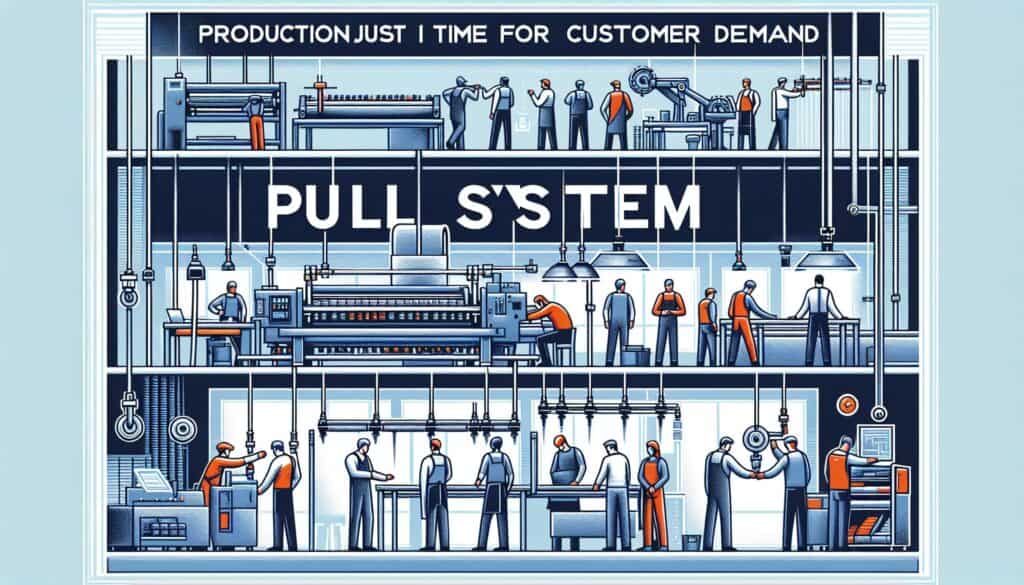To produce items only when they are needed by the next step in the process or by the customer, minimizing overproduction and inventory.
- Methodologies: Customers & Marketing, Economics, Product Design
Pull System

Pull System
- Continuous Improvement, Just-in-Time (JIT), Kanban, Lean Manufacturing, Process Improvement, Production Efficiency, Supply Chain, Value Stream Mapping, Waste Elimination Strategies
Objective:
How it’s used:
- A Lean manufacturing principle where downstream activities signal their needs to upstream activities. Work is "pulled" through the system based on actual demand, often using tools like Kanban cards.
Pros
- Reduces waste (especially overproduction and inventory); Improves flow efficiency and responsiveness; Lowers storage costs; Increases customer satisfaction through timely delivery.
Cons
- Requires reliable suppliers and stable demand for optimal performance; Can be difficult to implement in complex supply chains or with highly variable demand; Requires disciplined execution and communication.
Categories:
- Lean Sigma, Manufacturing
Best for:
- Controlling the flow of resources in a production process by replacing only what has been consumed, driven by actual customer demand.
The Pull System methodology is prominently utilized in various industries such as automotive, electronics, and consumer goods, where customer demands fluctuate and need accurate synchronization with production processes. This approach is particularly effective during the production phase where ongoing assessment of consumer need dictates the pace of manufacturing, thereby facilitating a more agile response to market changes. Participants in this methodology typically include cross-functional teams that engage in transparent communication, allowing for real-time data sharing and decision-making based on actual consumption rather than forecasts. For example, in the automotive industry, manufacturers often employ Kanban boards to visualize workflow and inventory status, ensuring that components are replenished as they are used, thereby minimizing excess stock and associated carrying costs. By encouraging workers on the assembly line to signal when parts are needed, organizations can ensure that they are only producing what is required by the next step in the process. This not only enhances operational efficiency but also contributes to a culture of continuous improvement where feedback loops inform adjustments in production strategy. Tools such as value stream mapping often accompany the Pull System to identify and eliminate waste, fostering an environment of continuous refinement. Such methodologies have been integral in enhancing customer satisfaction by optimizing lead times and increasing product availability without the burden of overproduction.
Key steps of this methodology
- Identify the final product and its requirements from customer feedback.
- Map the value stream to visualize processes and identify wasteful practices.
- Define pull signals, such as Kanban cards, to indicate when to produce or move items.
- Implement systems to react to pull signals, adjusting production based on demand.
- Establish limits for work in progress (WIP) to enhance flow control and efficiency.
- Continuously review and refine processes to align with actual customer needs.
- Train all team members on the pull system principles and their applications.
- Encourage proactive communication and feedback between upstream and downstream processes.
Pro Tips
- Implement robust visual management techniques to enhance visibility of work in progress and real-time status updates for improved decision-making.
- Regularly analyze lead times and cycle times to identify bottlenecks and continually refine the pull system for optimal performance.
- Encourage cross-functional collaboration to ensure alignment between production and demand signals, enhancing responsiveness and agility.
To read and compare several methodologies, we recommend the
> Extensive Methodologies Repository <
together with the 400+ other methodologies.
Your comments on this methodology or additional info are welcome on the comment section below ↓ , so as any engineering-related ideas or links.
Historical Context
1930
1940
1950
1950
1958
1960
1960
1930
1940
1949
1950
1950
1960
1960
1960
(if date is unknown or not relevant, e.g. "fluid mechanics", a rounded estimation of its notable emergence is provided)















Related Posts
METS to Calories Calculator
Meta-Analysis
Message Mapping
Mental Model Diagrams
Maximum Acceptable Pushing and Pulling Forces
Material Requirements Planning (MRP)